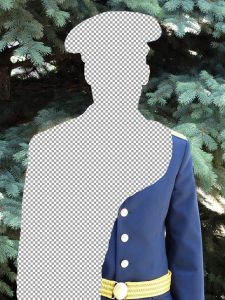You might remember that a year ago Marc Owens designed the Avatar Machine, a system which replicates the aesthetics and visuals of third person gaming, allowing the user to view themselves as a virtual character in real space via a head mounted interface.
![]()
His reflections on identity and gaming didn’t stop there, during the Royal College of Art Summer show, the Platform 11 graduate was exhibiting his latest game-inspired works.
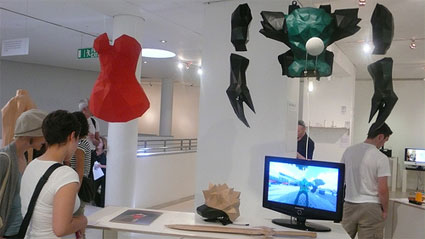
A study by psychologists at Nottingham Trent University has found that 54 percent of all males and 68 percent of all females “gender swap”–or create online personas of their opposite sex.
A real life manifestation of that practice, the Virtual Transgender Suit replicates the aesthetics of the typical virtual female form and catapults them within a real world context. The piece was specifically designed for men to wear in the real world, creating a bridge between real (where cross-dressing is not really socially accepted) and virtual.
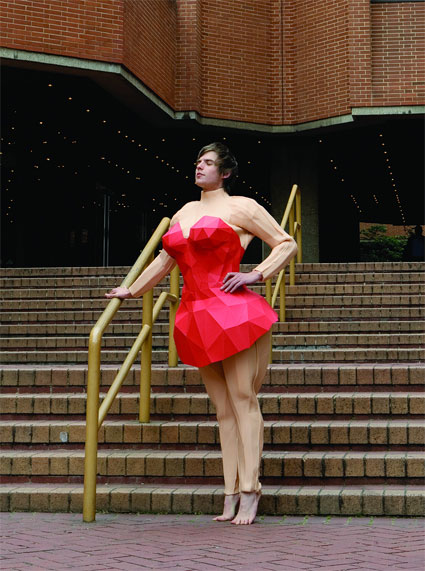
Another of Owens’ projects, Sabre & Mace – Second Death, was concerned more specifically with the online environment Second Life.
Collaborating with Tony Mullin, he created SABRE & MACE, a company that offers virtual characters the opportunity to experience death as a way to close their user account permanently. The project examines the notion of feeling sentimental toward a virtual character and examines the link between sentimentality and tangibility.
While researching the project, the designers discovered that a great deal of second life residents have multiple avatars, some stay in favour for a long time while others lose their interest. One guy who they spoke to had 14. He said that he used a many of them as platforms for different sides of his real life personality, and for others he invented entirely new fantasy personalities. However he admitted that some of his created avatars had fallen by the wayside and he no longer used them.
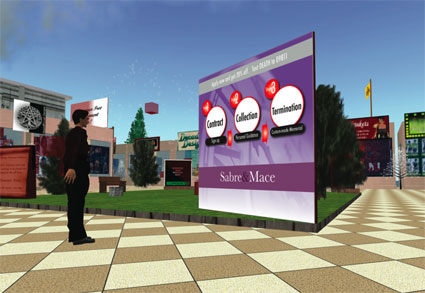
The service works as follows: Having discovered the Sabre&Mace site on-line (unfortunately the website had to be taken down after the show) or through one of the virtual adverts in Second Life, the prospective customer teleports to the company headquarters.

There, the client meets a manager who explains the full process and guides him or her through the signing of two contacts. Contract 1 – states that at some point (completely random) in their second life the avatar will be collected by a Sabre & Mace officer and taken back to the headquarters for termination.
Contract 2 is in fact the client’s ‘Last will and Testament’ where he or she outlines how they wish their virtual moneys, land and assests to be distributed once they have been terminated.
The client continues to live their second life until one day, a Sabre & Mace officer appears and informs them that the final proceedings are about to begin. The client is collected and taken to the Sabre & Mace HQ.
The client meets again with the client manager, to discuss the final process. At this point the client reveals their ‘account password’, which is the means by which the avatar is terminated.
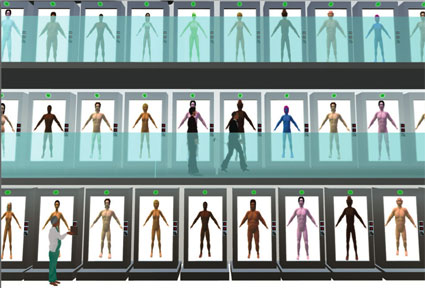
The client is led through the cryogenic chamber, where the virtual physical forms of past clients are stored. Upon arrival at the ‘Termination Room’, the client is instructed to walk through the ‘white noise’ door. Once he crosses the threshold of the door his Second Life game crashes, giving a Sabre & Mace member of staff time to change the clients password – effectively terminating the character.
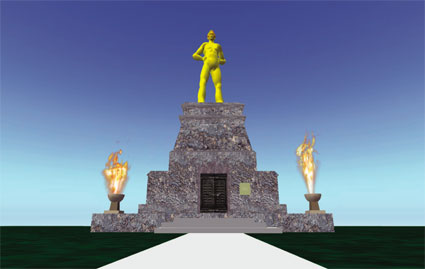
The client’s former avatar is immortalised as a golden statue. Information about the avatar can be read on the plaque which sits on the monument. Should the client visit the Sabre & Mace memorial gardens he would see his own statue as well as the monuments of previous clients.
Images courtesy of Marc Owens (except the shot of his works at the RCA show.)
Related stories: Mourning and digital culture.





